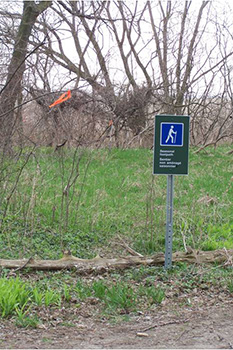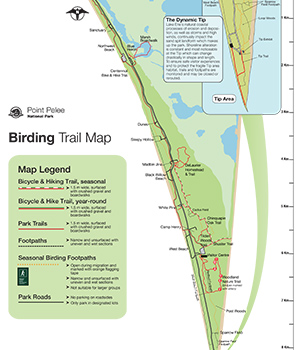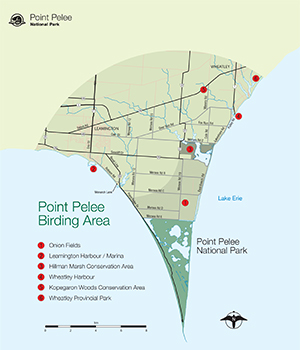Best places for bird watching
Point Pelee National Park
Point Pelee National Park is one of the best inland locations to observe bird migration. Its location on major migratory flyways and on the north shore of Lake Erie makes it a migrant trap – a place that attracts a wide diversity of species in a very small area. More than 390 species of birds have been recorded in the Point Pelee Birding Area.
Inside the park

The park offers more than 20 km of trails in spring for birding, including seasonal birding footpaths that are marked with orange flagging tape.
- Marsh
- Staging area for waterfowl and the place to look for rails, bitterns and herons. Accessed at the Marsh Boardwalk and Sanctuary lookout.
- Northwest Beach/Blue Heron
- Songbirds sometimes become concentrated in this area where the forest habitat is narrow. Park at Northwest Beach and explore the area on foot.
- DeLaurier Trail
- Open grassy areas attract sparrows and provide vistas for hawk watching. Pick up the Centenntial Trail into Yellow-breasted Chat territory.
- Tilden Woods
- Water-filled sloughs attract songbirds, especially waterthrushes. Explore the seasonal birding footpaths to get the most out of your visit to this area.
- Woodland Nature Trail & Post Woods
- Upland and swamp forest meet along these trails, attracting a wide variety of songbirds.
- Sparrow Field
- Restored savannah provides prime habitat for migrating sparrows.
- Tip Area
- Wooded areas are excellent for migrating songbirds in spring and fall. Sandspit is a resting area for gulls and shorebirds. Surrounding lake is a staging area for waterfowl. Excellent hawk viewing in the fall.
- West Beach Footpath
- Restored savannahs provide habitat for sparrows and thickets for Yellow-breasted Chat.
During the Festival of Birds, demand for parking near the Visitor Centre is high. As the parking spots are filled, the lots will be closed and it will be necessary to spread out in the park. With restrictions on the number of people that can access some of the more popular/famous birding areas in the park, you may find yourself exploring some hidden gems.
Here are some tips and tricks to get the most of your time spent in areas that may be new to you if the Visitor Centre and Tip areas are at capacity: Hidden Birding Gems, PDF 593Kb
Outside the Park
- Onion Fields
- Excellent for shorebirds and waterfowl. Roads are very narrow - use caution and avoid blocking traffic.
- Hillman Marsh Conservation Area
- Managed shorebird habitat in spring. Staging area for waterfowl with a 4 km diked loop trail.
- Wheatley Harbour
- Roosting area for gulls and terns. Associated creek is excellent for Great Egrets.
- Kopegaren Woods Conservation Area
- Small woodlot with walking trails, good for spring migrants and wildflowers.
- Wheatley Provincial Park
- Camping and walking trails. The creek through the site is good for marsh species.
Trails, paths, and roads
- Bicycle & Hiking Trail, year-round
- 1.5 m wide, surfaced with crushed gravel and boardwalks
- Footpaths
- Narrow and unsurfaced with uneven and wet sections
- Seasonal Birding Footpaths
- Open during migration and marked with orange flagging tape
- Narrow and unsurfaced with uneven and wet sections
- Not suitable for larger groups
- Bicycle & Hiking Trail, seasonal
- Walking trail only during spring birding season (mid April through May)
- 1.5 m wide, surfaced with crushed gravel and boardwalks
- Park Trails
- 1.5 m wide, surfaced with crushed gravel and boardwalks
- Park Roads
- No parking on roadsides
- Only park in designated lots
The Dynamic Tip
Lake Erie's natural coastal processes of erosion and deposition, as well as storms and high winds, continually impact the sand spit landform which makes up the park. Shoreline alteration is constant and most noticeable at the Tip which can change drastically in shape and length. To ensure safe visitor experiences and to protect the fragile Tip area habitat, trails and footpaths are monitored and may be closed or rerouted.
Ticks
Ticks are a part of our environment and a small percentage of the park’s black-legged tick population carries the Lyme Disease bacterium.
For more information on Lyme disease, blacklegged ticks, and how to protect yourself from tick bites while enjoying the outdoors, visit the Public Health Agency of Canada.
Information about precautions is available at the Visitor Centre.
- Date modified :

